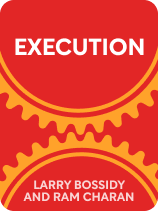

This article is an excerpt from the Shortform book guide to "Execution" by Larry Bossidy and Ram Charan. Shortform has the world's best summaries and analyses of books you should be reading.
Like this article? Sign up for a free trial here .
Does it feel like many of your applicants are underqualified? How can you find and retain talent at your company?
With such a competitive job market, there’s an abundance of applicants to sift through. The problem is that it’s difficult to tell which of those applicants would be a good fit for your company. Additionally, once you’ve chosen to hire someone, it can be just as challenging to keep them.
Here are some tips on finding and retaining talent from the book Execution.
How to Find, Retain, and Develop Top Talent
Bossidy and Charan say that having high-quality talent always gives your company a strong competitive advantage. The skills and decision-making abilities of your people will either hinder or advance your company’s success. But businesses don’t always succeed in finding top talent.
Let’s discuss why businesses often choose the wrong people for leadership roles. Then, we’ll explore how to find and retain talent in the long term:
- Choosing the right people
- Keeping people accountable and making them better
- Safeguarding against shortages of talent
Why the Wrong People Get Chosen for Leadership Positions
Leaders make several common mistakes when they seek new talent or promote people to new positions. First, they use traditional interviews, which are insufficient. These interviews, say Bossidy and Charan, typically focus on a candidate’s intellectual prowess and educational attainments. Given that focus, traditional interviews grant an advantage to the person with impressive credentials, but the motivated, less flashy go-getter might be the better fit. Furthermore, traditional interview questions don’t tap into key qualities needed to lead well, like the ability to teach and inspire others or make quick, thoughtful judgment calls.
(Shortform note: Another arguably more pervasive and serious problem with traditional interviews is the potential for leaders’ implicit stereotypes to influence their hiring decisions, which could reduce opportunities for diverse candidates such as women and Black individuals. That said, there are benefits to traditional interviews that the authors don’t mention, including the opportunity to develop rapport with candidates and deliver nonverbal cues that guide the discussion. Nodding, smiling, tilting your head, and raising your eyebrows can encourage the candidate to expand with details on a particular issue that’s relevant to the open position.)
The second common mistake leaders make when hiring is relying on recommendations from their direct reports that don’t take the job requirements into account. A junior manager might say, “Jo sets a fantastic example for the whole team. She shows up early, asks smart questions, and goes out of her way to contribute.” These general qualities might make Jo great in her current role, but she may be totally unqualified for leadership. Bossidy and Charan advise that you assess each proposed candidate, above all else, against the skills needed for the job.
(Shortform note: Many companies now get candidate recommendations not from current employees but through recruitment agencies. This may be a way to identify candidates who match your unique needs, especially for leadership or highly technical positions. Recruitment agencies often have staff members with expertise in particular sectors, which enables them to spot industry-specific skills that your in-house team may miss. Using a recruitment agency can also save your company time by finding qualified candidates quickly, freeing your employees to focus their efforts elsewhere.)
Third, leaders can’t bring themselves to say no or deliver bad news. As a result, they keep nonperformers on board way too long and elevate underperformers who aren’t ready for more responsibility. This, the authors caution, can demoralize people who are performing and cause real harm to the company.
(Shortform note: Bossidy and Charan’s warning here focuses on protecting the morale of your top performers by not keeping or promoting problematic team members. But what if the top performers are the problematic ones? Some top performers can have dominant personalities that alienate their colleagues. In these cases, it’s up to you to intervene. Deliver straightforward feedback, prompt the top performer to consider their impact on teammates, and help them develop self-awareness.)
How to Choose the Right People
So how can you avoid these pitfalls and trust that you’re selecting the right people for the right jobs? First, Bossidy and Charan suggest, engage in interviews that dig beneath the surface of education, industry knowledge, and past achievements. Ask questions like “If you knew your division would not meet sales goals this quarter, what steps would you take?” or “How do you foster collaboration and open communication among your team members?” This will give you insight into how the candidate makes decisions and how well they will fit into your company culture.
Second, have in-depth conversations with at least two references who you trust to tell you the truth—not only about what someone accomplished but also about how they did it and the skills they used. Pose questions such as “How would you describe their management style?” “Did they nurture their direct reports or alienate them?” “When their department surged in revenue, did that come at the expense of another department?” The authors explain that the answers to such questions will shed light on a candidate’s strengths and weaknesses, as well as the extent to which they prioritize their career growth over company goals.
Third, assess candidates’ work efforts and outcomes. This partly involves reviewing measurable results a candidate produced, such as revenue generated and the number of sales completed. But go beyond quantifiable metrics to also assess their interpersonal skills and adaptability. Bossidy and Charan advise you to consider a candidate’s energy, engagement, and ability to manage a high workload.
How to Keep People Accountable and Support Their Development
Once you’ve selected the right people for your team, it’s your job as the leader to both hold them accountable and ensure they are continually improving. As Bossidy and Charan remind us, accountability and constant improvement keep everyone making progress toward the goals that matter.
To hold people accountable and ensure their improvement, follow these steps:
Step #1: Make sure everyone is clear about the outcomes every team member is responsible for, their priorities, and the short-term benchmarks they’re expected to hit. That way, say Bossidy and Charan, people can coordinate their efforts to reach the targets that support long-term goals.
(Shortform note: Leaders cannot personally ensure everyone at their company is clear about everyone’s outcomes, priorities, and goals, especially in large companies—a limitation that Bossidy and Charan don’t acknowledge. In Extreme Ownership, Jocko Willink and Leif Babin contend that leaders can only effectively manage about six to 10 people. To acknowledge this limitation and limit your oversight responsibilities, enlist junior managers to keep an eye on groups of team members who you don’t have time to manage.)
Step #2: Follow up rigorously with people in leadership roles so you stay informed about their progress and challenges. Regular check-ins give you an opportunity to offer support, detect risks on the horizon, and adjust plans accordingly.
(Shortform note: In The New One Minute Manager, Ken Blanchard and Spencer Johnson discuss how to perform these touchpoints efficiently through one-minute goal-setting sessions, praising sessions, and redirects that empower and motivate employees. Goal-setting sessions involve the manager and employee defining specific, measurable goals with clear outcomes and deadlines. In praising sessions, a manager delivers specific, positive feedback in real time when they see their employee doing something valuable that advances company goals. In redirects, a manager provides immediate feedback when they see an employee make a mistake, which helps the employee learn from errors.)
Step #3: Have candid performance reviews with direct reports. Clarify what’s working, what’s not working, and what needs to improve—and make sure this is a two-way conversation so you get a clear picture of the challenges and opportunities in play. Then, send a memo after each review that documents any agreements you made during the meeting, next steps, and when the next check-in will be. This, Bossidy and Charan underscore, eliminates confusion about who’s doing what by when.
(Shortform note: Bossidy and Charan don’t address creating sensitive memos specifically related to employee conduct violations or performance issues that emerge during reviews. You can guard against legal complications, such as accusations of discrimination or retaliation, by following standard protocol around documenting violations. Best practices include avoiding statements of opinion and providing concrete examples of violations.)
Step #4: Reward people who deliver results and withhold rewards from people who fail to meet expectations. This will reinforce the standards you’ve set and incentivize people to optimize their performance.
(Shortform note: What types of rewards should you give your employees? Rather than offering a generic reward like a monetary bonus, you might consider impressing your employees with a more creative and thoughtful gift. Ideas for creative rewards include reduced prescription drug costs, a thank-you video, movie tickets, or a spa day.)
Safeguard Against Talent Shortages
Unfortunately, you can never guarantee that the talented people you hire will stay or develop as you thought they would. This can lead to staffing shortages, when team members either leave the company or get fired. Let’s examine some risks that could leave you vulnerable to staffing shortages and ways you can mitigate those risks.
Risk #1: Not having enough qualified people lined up to succeed current leaders—To manage this risk, Bossidy and Charan advise you to have solid talent development plans in place. This will give you a constant stream of internal candidates who can step into roles.
(Shortform note: Bossidy and Charan don’t provide clear suggestions for creating and implementing talent development plans. One-to-one mentorship can be especially valuable for high-potential employees who need support with particular skills, such as communication and leading a team. It may make more sense to pair them with mentors who’ve mastered those skills, even if they work in a separate department. Employees could also access external learning programs—online, in-person, or hybrid—that are not available internally.)
Risk #2: Vacant positions due to unexpected departures of key staff—Look out for red flags that someone might be inclined to leave. The authors recommend considering factors such as how marketable someone is to potential recruiters, their potential, and how long they’ve been stagnant in the same position. Also, assess whether people have been adequately rewarded for their contributions. If you spot any red flags, consider how you could entice the person to stay.
Risk #3: Not having people with the skills needed for the company’s next stage of growth—Your staff might be performing their current roles well, but that doesn’t mean they’re equipped to handle increased responsibilities following growth, such as a higher sales volume or launching a product overseas. Bossidy and Charan urge you to anticipate what skills you’ll need next quarter or next year, and be proactive in having qualified people ready to fill those roles.
Risk #4: Letting poor performers linger—Keeping poor performers on board in their current positions can destroy morale, sabotage the business, and send high performers running. Explore all options to eliminate this risk on a case-by-case basis. The authors suggest putting poor performers on a development plan, moving them to another position, or firing them. While all of these options can be emotionally challenging for both leader and subordinate, they’re necessary to keep your company strong.
(Shortform note: Bossidy and Charan acknowledge that handling poor performers can be emotional and difficult, but they don’t provide any guidance on how to deal with this challenge. In First, Break All the Rules, Marcus Buckingham and Curt Coffman provide practical advice on moving someone out of a role that isn’t a good fit. When having these conversations, stay composed and consistent in your feedback, and remember that removing an underperformer will benefit the rest of the team. Also, be sure to acknowledge that the employee does have talent, just not the talent needed for this particular position.)

———End of Preview———
Like what you just read? Read the rest of the world's best book summary and analysis of Larry Bossidy and Ram Charan's "Execution" at Shortform .
Here's what you'll find in our full Execution summary :
- What execution in business is and why it matters
- The three core functions that leaders must perform to execute well
- The three important qualities leaders must have to execute well






